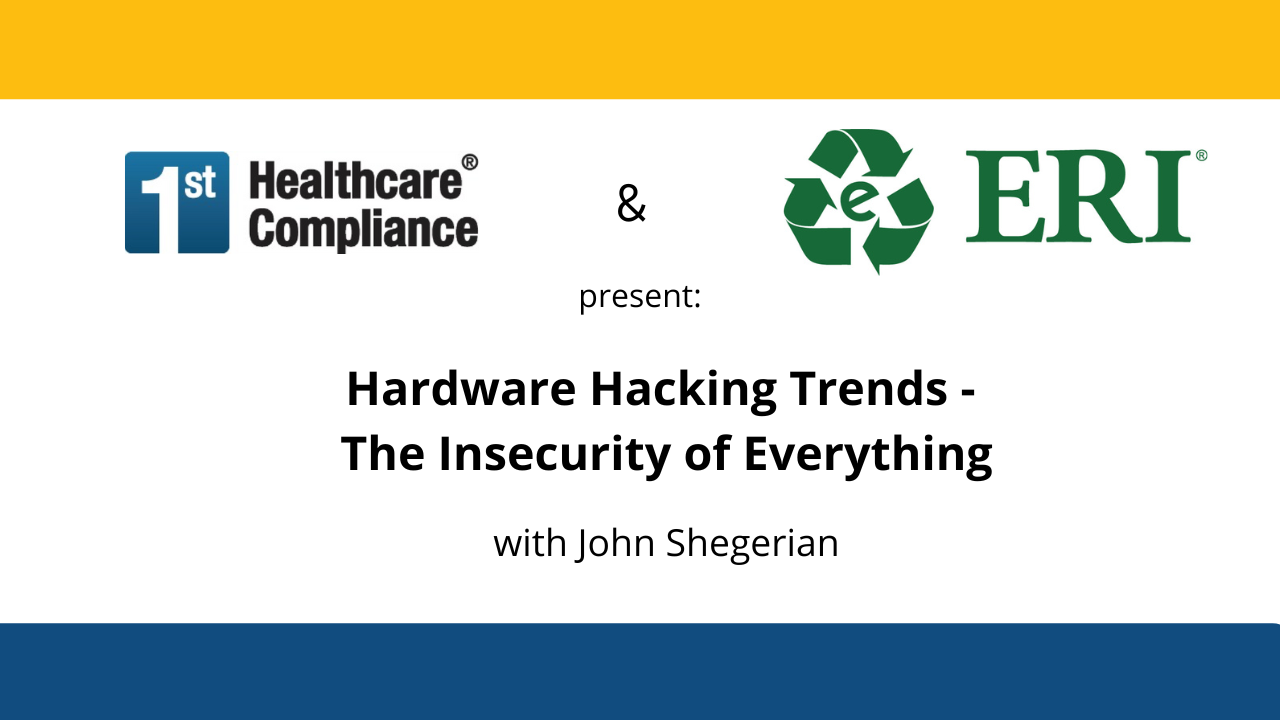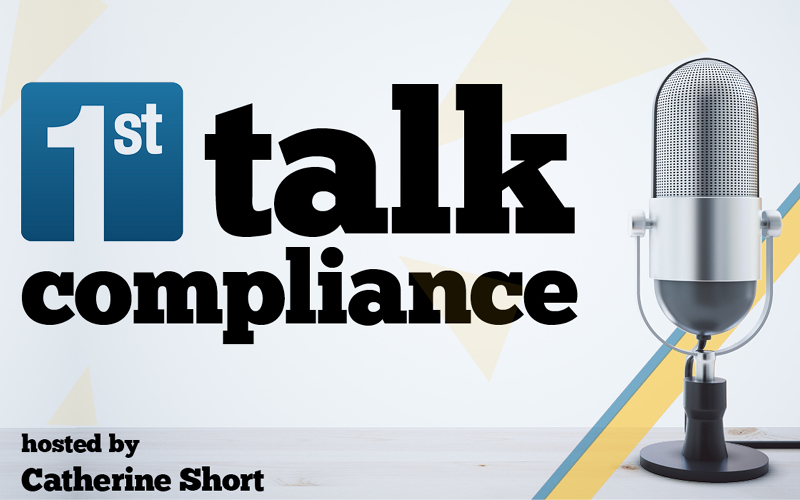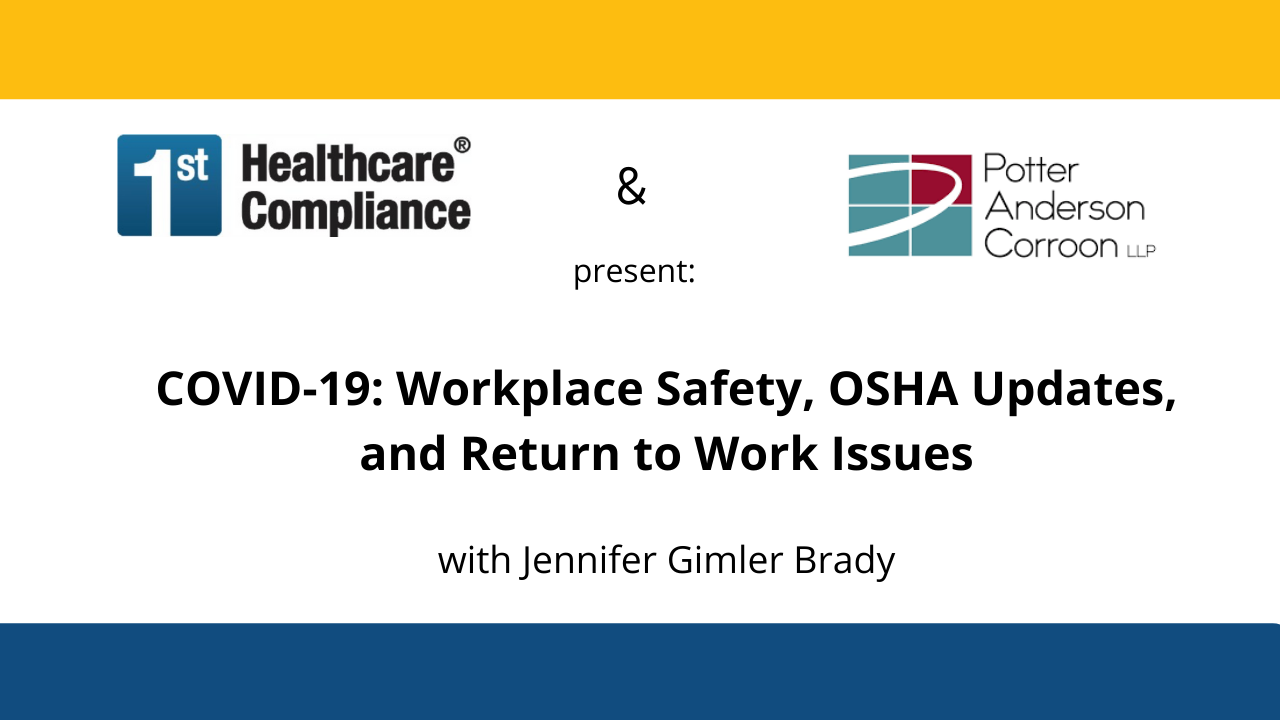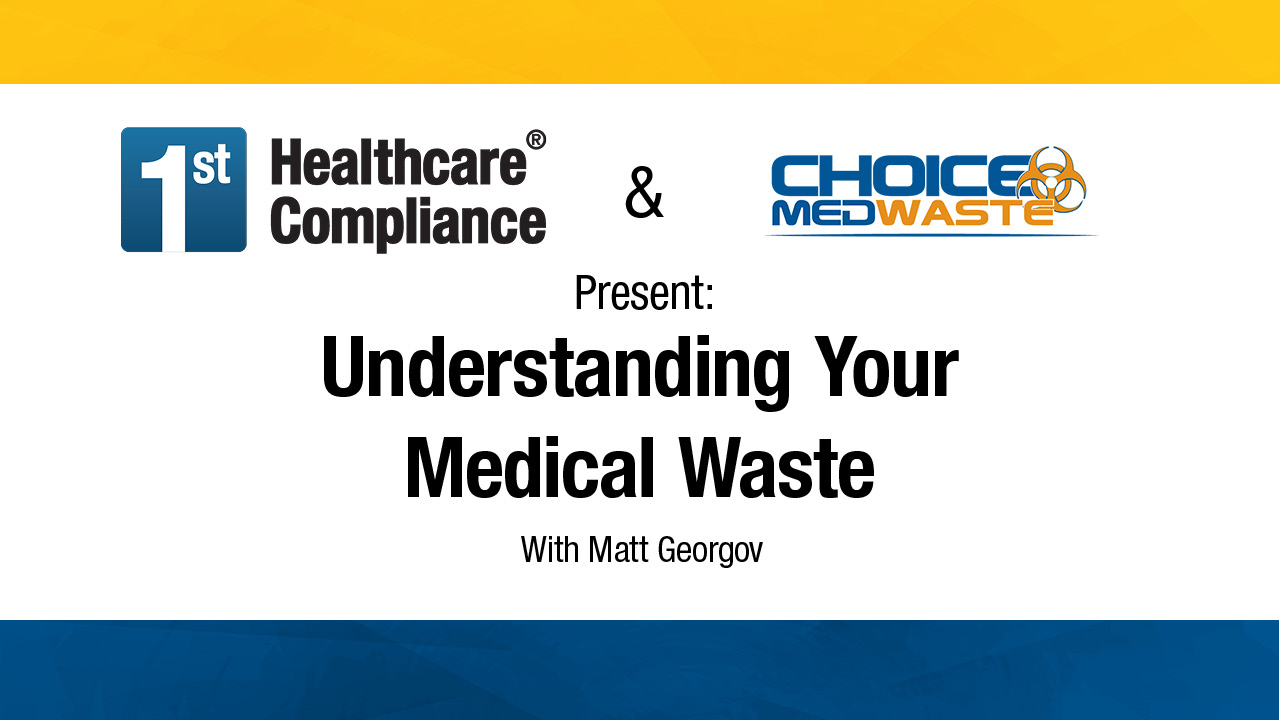Employment and Labor Law Digest
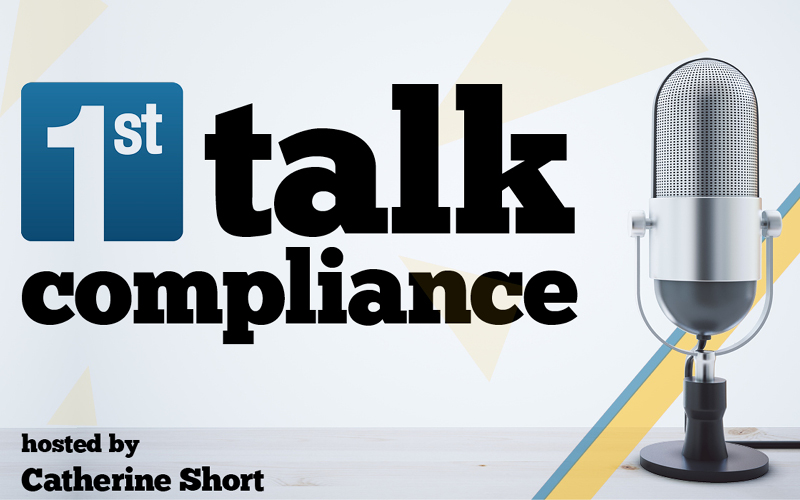
1st Talk Compliance features guest Catherine Walters, a partner at BYBEL RUTLEDGE LLP and management-side labor and employment attorney representing employers of all sizes, on the topic of “Employment and Labor Law Digest.” Catherine joins our host, Catherine Short to update employers and human resources professionals on recent employment and labor law developments and discuss specific hot topics.
Subscribe: Amazon Music | Email | RSS | More
Catherine Short: 0:01
Welcome and let’s 1st talk compliance. I’m Catherine Short, Manager of Virtual Education at First Healthcare Compliance. Thanks for tuning in. This show is brought to you by First Healthcare Compliance as part of our commitment to provide high quality complementary educational resources. We help create confidence among compliance professionals throughout the United States. Please show your support by taking a moment to provide a review on Google, Facebook, or iTunes. You can also follow us on Instagram, Twitter, and subscribe to our YouTube channel.
On today’s episode, we are speaking with Catherine Walters, Partner at Bybel Rutledge LLP, where she is a management side labor and employment attorney representing employers of all sizes on the topic of employment and labor law digest. This program will provide a quick update of 2021’s most important developments and forecast what employers can expect for 2022. We will update employers and human resource professionals on recent employment and labor law developments, discuss specific hot topics of interest to employers and human resource professionals, and provide ideas regarding anticipated changes in the labor and employment law arena for 2022.
Before we begin, at First Healthcare Compliance, we serve as a trusted resource for compliance professionals and celebrate their hard work and dedication with our compliance Super Ninja recognition. For this Super Ninja, our team is turning the spotlight on Mindy Mayberry, Practice Administrator at ENT Specialists. Mindy says “I have the best group of physicians and staff. We have a close-knit team at ENT Specialists PC that we consider family.” Congratulations Mindy our team is honored to have the privilege of working with you.
Thank you, Catherine, for joining me on 1st Talk Compliance. It’s a pleasure to have you on
Catherine Walters: 2:10
My pleasure to be here Catherine, I enjoy working with you.
Catherine Short: 2:14
Great, I do too. It’s always nice to have you and your insights. So Catherine, we have a broad range of topics to discuss here today. Can we go through some of your top concerns for employers in 2022?
Catherine Walters: 2:30
Absolutely. You know, I have a lot of concerns for employers, but trying to put them in a specific order is a good idea because I think that some of them are much more imminent than others. If we want to get started, I can talk about COVID issues. It remains top of mind because there are no consistent standards for employers to follow. I am unusually in favor of the Occupational Safety and Health Administration, OSHA. I am a defense attorney so I really represent employers, but I do think that OSHA does a marvelous job of attempting to create safe workplaces, and a safe workplace is the best kind of workplace you can have. With COVID, we’ve not been able to get any consistent standards for employers to follow not for lack of trying by OSHA, but really because the OSHA standards keep getting kicked around, batted down, and finally shot down by the US Supreme Court. Ultimately, OSHA tried to put together an emergency temporary standard that dealt with vaccination and testing for employers with 100 or more employees and the long and the short is that emergency temporary standard has been shot down by the US Supreme Court as of January 13 of this year and as a result, employers have been left with no consistent standards to follow. If you look at the United States, it’s a patchwork of different state laws, different municipal laws, just a patchwork of differing things that employers have to try to abide by. Some of the laws prevent employers from enforcing certain types of rules and others require the enforcement of certain kinds of rules. So an employer really is between a rock and a hard place without some type of consistent national standard.
Catherine Short: 4:40
Well, onto another issue. The OFCCP issues. If you can explain what the OFCCP is, first of all, and discuss issues concerning this.
Catherine Walters: 4:54
Sure. The OFCCP means Office of Federal Contract Compliance Programs. It’s basically considered to be the federal watchdog with respect to federal contractors who receive federal monies to perform work or provide products. The OFCCP enforces a number of laws as to employers. Primarily it enforces Executive Order 11246, which requires affirmative action on behalf of minorities and females. Then there’s the Rehabilitation Act, Section 504 of the Rehabilitation Act, which requires employers to provide affirmative action and equal opportunity to individuals with disabilities. Then there’s also the Vietnam Veterans, VEVRAA. OFCCP enforces the Vietnam Veterans law as well, and it requires affirmative action on behalf of protected veterans. It’s not just Vietnam veterans at this point, affirmative action is typically applicable to federal contractors with varying sizes of federal contracts, and numbers of employees 50 or more employees, and you have to have a written plan. What we see on an annual basis is employers who must update their affirmative action plans. So every year, a federal contractor will update those plans. The OFCCP is the one that not only monitors those plans but accepts charges of discrimination and investigates those. They’re really focused on discrimination and much of their focus is on systemic discrimination, as opposed to individual discriminations. What you’ll have in many situations is what we call disparate treatment versus disparate impact. Disparate treatment is where you treat one person differently from another or one group or class of employees differently from another.
Catherine Walters: 7:06
There’s the new SAM requirements. SAM, is the System for Award Management database. Federal contractors have to sign up with that portal in order to qualify for government contracts. This has never happened in the past, but we have a new affirmative action plan reporting requirement that will go into effect. In essence, under the SAM declarations page, contractors are going to have to begin affirming that they have developed and maintained affirmative action programs at each establishment as applicable. This is an initiative that is commencing now. By March 31, contractors shall be able to access that portal to certify their affirmative action planning compliance. By June 30, contractors must certify whether they have developed and maintained their affirmative action program for each establishment or functional unit as might apply to them. This was where the OFCCP lacked teeth. In many instances, in the past, employers were able to get away with not having their programs in place or updating their plans on a regular basis. A lot of contractors think they have an affirmative action plan and it’s in some dusty binder on some dusty shelf in some closet somewhere. It’s an annual exercise and it has to be done at least annually and be done even more regularly. You can have short plans, but you can’t have a plan that goes beyond 12 months. This will require people to give more thought to making these certifications, because to make a certification is very important. Under SAM, if you lie about it, you could be disbarred.
I would say then that this will enable OFCCP to select people for audit. Once selected for audit, the contractors would actually submit their plans through the portal. It’s going to be interesting to see how many contractors decide that they want to continue being federal contractors. I think we’ll lose some people as a result of these new certifications because a lot of contractors that don’t have huge amounts of government contracts, they consistently look at whether they want to continue being federal contractors and some of them decided against doing it because there are too many overlays, other legal overlays, particularly on the employment side of things and that’s just one of the affirmative action. So many times you’ll see contractors reassess their status and decide to pull out. Those who stay in it are going to make these certifications, they have to be accurate. So we’re going to see more of an uptick in employers actually working on their affirmative action plans.
For a number of other things going on too at OFCCP, for example, they are targeting non discrimination in hiring and compensation. They’ve always done that but they’re using another approach to it. Basically, compliance with affirmative action. It’s really just the beginning of meeting OFCCP obligations. The executive order adds other non discrimination obligations. I think that we’re going to see a real heightened scrutiny of application screening. Right now, a lot of employers use artificial intelligence to screen applicants. They have online applications, and they get thousands upon thousands of applicants for a couple of positions, in good times. What the OFCCP plans to do, both on its own and in conjunction with the EEOC, is to look more closely at the contractors who use these routine application screening tools. Are they screening for race, or sex, or LGBTQ status or disability? Are they screening for it and then screening them out? Basically, these are tools that can be misused, even unintentionally. They screen for certain words, or certain indicators, and those people are often simply eliminated from the applicant pool without more. So, to the extent contractors use these tools beyond their intended purpose, and they’re not monitoring any potential disparate impact, contractors will be at risk of becoming targets of the OFCCP’s audit and enforcement approaches. If I were using one of these software programs, or even several of them to work my way through applicants for employment, I would take a really good look at them. I know your vendors will typically provide validation studies, but you want to take a look at how you’re using them and what you’re screening for. It’s just a quick reminder to employers that use these tools that they should pay more attention to them because the OFCCP and the EEOC are going to be looking closely at that in the coming year or two.
There’s some other things that are going on, that I think are important to mention as well at the OFCCP. I think that we’re going to see more use again, or a reversion to the OFCCP’s use, of statistical methods to assess whether pay equity has been compromised in a contractor’s workforce. We’re going to see that basically detailed pay equity assessments. One of the other things that is really concerning, at least it should be concerning, to subcontractors and suppliers is that the Department of Labor’s full regulatory agenda proposed a new rule that would add provisions to the regulations that implement Executive Order 11246 and require contractors to provide notice to the OFCCP when they actually award supply and service contracts or subcontracts. This doesn’t exist as the rule right now but the OFCCP is looking at implementing this. I don’t know if it will happen or when it will happen, but this combined with the SAM portal certification requirements suggests that the OFCCP is going to use the contractors themselves to drill down and identify potential new meat to go after in terms of audit and investigation because a lot of the subcontractor and supplier subcontractors, they don’t meet their affirmative action obligations even though they have them and there’s almost no way that that the OFCCP will be aware of them without having audited the primary contractor or without any of those subcontractors identifying themselves on their EEO-1 forms as federal contractors.
Catherine Short: 14:53
If you’re just tuning in, you’re listening to 1st Talk Compliance brought to you by First Healthcare Compliance as part of our commitment to provide high quality, complimentary educational resources. We help create confidence among compliance professionals throughout the United States. My guest today is Catherine Walters partner at Bybel Rutledge on the topic of employment and labor law digest. Please show your support by taking a moment to provide a review of First Healthcare Compliance on Google or Facebook, you can also follow us and subscribe on all forms of social media.
Catherine Short:
I don’t think that I had ever heard the words affirmative action used outside of perhaps a college or university setting. Is this synonymous with how we hear diversity and inclusion and the workplace?
Catherine Walters: 15:46
I wouldn’t say it’s synonymous, but they definitely dovetail with each other. Remember that affirmative action is really focused on federal contractors, although a lot of employers have what we call voluntary plans, and then there are some constitutional plans out there for public sector employers. You mentioned the college affirmative action programs. There’s one out there right now before the Supreme Court, has to do with Harvard, that focuses on race conscious recruiting or admissions in order to diversify the campus, right? To diversify the people on the campus. There’s a little bit of a difference between the way the colleges and universities do it. Their focus is, it had originally been, on providing opportunities to underrepresented communities, and giving them a leg up, then it has morphed more into how to diversify your campus life. When we look at that in comparison with employers, on the one side of things, you’ve got recruitment and hiring, which really relates to federal contractors, whereas you’ve got diversity and inclusion, more of the bent of the campus ones. In between that are the employers that may not have affirmative action plans, but they are focused on diversity and inclusion in their workforces. The difference between affirmative action employers, and diversity and inclusion, where the employer doesn’t necessarily have an affirmative action plan, is that diversity inclusion is about minorities and females and individuals with disabilities and veterans and everybody else who’s a protected class, getting them in the door, but it’s more about retention. How do we retain people? How do we integrate them into our workforce? How do we benefit within our workforce from the diversity that each of these individuals brings to us? The more differences you bring into your workplace, the more everybody learns, and the more evolved your workforce gets.
Catherine Short: 18:13
Okay, no, that helps a lot. Thank you for the explanation. I appreciate that. Is remote work here to stay?
Catherine Walters: 18:21
In a word? Yes. At least for employers who can accommodate remote work. As I indicated earlier, I think that there are a lot of employers that can’t accommodate remote work. Of course, there’s the hybrid type where some workers must be in person and others can be remote. I do think to the extent an employer is able to have remote work, I think it’s here to stay. Some of the big issues really are about adapting your employment processes to this new normal. We look at every employment process that an employer uses and try to assess, how does that apply where the person isn’t really here? So we focus on recruiting and virtual recruiting and interviews and how do we really assess a person if we can’t see them in person? It’s not so bad on Zoom or Teams meetings at this point. I think we’re all accustomed to doing that now. But still, there’s nothing like that in person meeting. So again, how do we make accommodations and adapt for virtual or remote recruiting? And then onboarding that person once you’ve decided to hire them, how do we go about onboarding them? We can send them all the employee handbooks and things to sign that we want, but how do you introduce them to your team? How do you make them an integral part of a team and collaborating colleague? There’s all kinds of fun stuff to consider here. And then of course performance, we really are reverting over to performance as the measure of how we judge their performance. Productivity is the key. How do we judge performance? That gets you into rewriting your job descriptions and reassessing expectations for remote employees and how much work that they need to produce. Is it volume? Is it substance? What is it that you’re seeking from your employees? It gets back to productivity as opposed to how many hours they’re working, or what time of day they’re working. Are they producing the work that they’re supposed to be producing? Is it working? Now, of course, we have these behavioral issues, when we do have meetings, we’ve got people with their little side chats, or they’re making fun of other people on screen, they’re making nasty comments. Those are just minor issues but then, of course, you’ve got the people who are going to find new ways of harassing their coworkers. When you’re in person, it’s one thing. You can say things, you can be physical. When you’re remote, there’s just a whole raft of new things that we’re seeing. New creative behaviors to harass your colleagues. So we’ve got to identify those and determine how to identify and how to stop those because even though everybody’s remote, it doesn’t stop an employer from having obligations to prevent harassment and discrimination in the workplace. And then, of course, that leads you to the concept of, you know, how do we apply discipline to people? How do you know if somebody hasn’t shown up for work? How do you know if they’ve done something that you would typically discipline them for during an in person work day? That gets you back, of course, to the concept of productivity. So we have to reassess discipline. And of course, there’s everything else, whether it’s discharge or performance reviews, or any of the other things that an employer puts into assessing its employees and building those relationships, career advancement, discipline, all the things that go into having an employer employee relationship, have to be rethought, reassessed in light of the concept of remote work. I think it’s a big ask for a lot of employers, and it’s something that everyone has to do, and I’m hopeful that everyone can do it successfully now that we’re well into remote work.
Catherine Short: 22:36
Okay, the next area I want to ask about was enhanced Department of Labor enforcement.
Catherine Walters: 22:43
If we start with government contractors, I would say that both federal and state agencies are going to be moving forward with enhanced enforcement. So, we’ll continue to see the OFCCP transitioning back into an enforcement posture with the EEOC. We’re going to continue to see a rise in retaliation charges and other types of sex discrimination charges. And then of course, with online or remote work, we’re going to see a rise in online harassment charges. I think the EEOC, because it’s going to be working in conjunction with the OFCCP and the National Labor Relations Board to do sharing of information, we’re going to see all of those agencies banding together to identify potential employers that they identify as committing more violations than others. We’re going to see broader, more holistic or whole employment audits and investigations. It won’t just be looking at whether somebody’s engaged in disparate treatment. I think that analysis of the investigation or the analysis of discrimination will go broader to see whether there’s a systemic mistreatment or disparate impact or whether classes of people as opposed to just individuals are being treated differently from each other.
Catherine Short: 24:18
All right, great. Can you speak briefly about restrictive covenants?
Catherine Walters: 24:22
Certainly. Restrictive Covenants include things like non-competition agreements, non-solicitation agreements, non-interference and non-contact and so forth. Typically, employers use them to prevent valued employees from leaving them and going and competing with them at another workplace. In recent years, we’ve seen a lessening of the use of the noncompetition restriction, meaning that that person can go work somewhere else, but still, a use of non-solicitation, meaning that even though you can go to a competitor, you may not solicit clients or other customers that you had when you worked for me, and you can’t reach out to our employees and ask them to come with you. Basically, you can’t interfere with my relationships that I had, either before you were here, or while you were here, and you can’t do it for a year or two. Of course, that dovetails with confidentiality agreements, and the protection of confidential information and trade secrets for employers. With respect to restrictive covenants, some states in the United States have legislation against restrictive covenants in the employment field. It’s clear that restrictive covenants prevent employees from moving around, and this inability to move around or go to a competing employer prevents them from increasing wages and benefits as quickly as they might otherwise be able to do and it prevents them from growing in their careers in many cases. Restrictive covenants, while they’re legislated in many states, they aren’t legislated in others. So, there’s no consistent legislation about restrictive covenants in the United States. Some states, you can use them to your heart’s content, other states you can use them in very limited fashion, and in other states, they’re prohibited.
Catherine Short: 26:32
Well, thank you very much Catherine. Did you have any other words of advice you’d like to leave with us today?
Catherine Walters: 26:39
I think I’ve said just about everything there is to say, except buckle up. My concept is adapt or die. Everybody’s learned during COVID. If you can’t adapt, then you’re not going to make it and I think that employers just have to remain vigilant, they have to remain flexible, and they have to remain in the know as to what’s changing and happening around them so that they can swing with it and stay ahead of the curve. I say change is the key word, and for the next couple of years, just change, and buckle up for change.
Catherine Short: 27:18
Very good. Well, I wanted to thank you for being here today, it was our pleasure. So, thank you.
Catherine Walters: 27:24
Always a pleasure to work with you, Catherine, and all the other folks at First Healthcare Compliance, I can’t think of a nicer group of people to work with. Thank you for having me.
Catherine Short: 27:34
Very happy to have you here. I wanted to let our listeners know that Catherine is going to be one of our presenters at our Healthcare Compliance Symposium which is coming up on April 28. Make sure you get your tickets for that. Find those through our website and you can hear Catherine speaking at that event.
Thanks to our audience for tuning in to 1st Talk Compliance. You can learn more about the show on the program’s page on Healthcarenowradio.com and to lend your voice to the conversation on Twitter at @1sthcc or #1sttalkcompliance. You can also email me at catherineshort@1sthcc.com. I’m Catherine Short of First Healthcare Compliance. Remember, compliance is the key to achieving peace of mind

